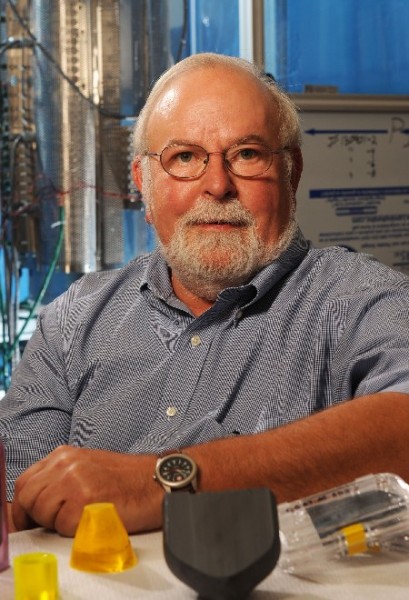Mar
9
Solar Power Could Be At Cost With Fossil Fuel Power
March 9, 2016 | 3 Comments

Kelvin Lynn, a Regents professor in the Washington State University School of Mechanical and Materials Engineering and Department of Physics, helped researchers reach a milestone in solar cell fabrication. Image Credit: Washington State University. Click image for the largest view.
This milestone is based on improving the maximum voltage available from a cadmium telluride (CdTe) solar cell, overcoming a practical limit that has been in place for six decades and is key to improving its cell efficiency.
The research paper has been published in Nature Energy.
Today silicon solar cells have a 90% share of the solar cell market, but it will be difficult to significantly reduce their manufacturing costs. CdTe solar cells offer a low-cost alternative. They have the lowest carbon footprint of any other solar technology and perform better than silicon in real world conditions, including in hot, humid weather and under low light. However, until recently, CdTe cells haven’t been as efficient as silicon-based cells.
One key area where CdTe technology has under performed was in the maximum voltage available from the solar cell, called open-circuit voltage. Limited by the quality of CdTe materials, researchers for the past 60 years were not able to get more than 900 millivolts out of the material, which was considered its practical limit.
The research team improved cell voltage by shifting away from a standard processing step using cadmium chloride. Instead, they placed a small number of phosphorus atoms on tellurium lattice sites and then carefully formed ideal interfaces between materials with different atomic spacing to complete the solar cell.
This approach improved the CdTe conductivity and carrier lifetime each by orders of magnitude, which enables the fabrication of CdTe solar cells with an open-circuit voltage breaking the 1-volt barrier for the first time. The innovation establishes new research paths for solar cells to become more efficient and provide electricity at lower cost than fossil fuels.
Kelvin Lynn, Regents professor in WSU’s School of Mechanical and Materials Engineering and Department of Physics, who led WSU’s part in the effort said, “It’s a significant milestone. It’s (CdTe cell technology ) been below 900 millivolts for decades.”
The NREL researchers treated the crystals, built and characterized the solar cells, while WSU researchers, including Santosh Swain and Tursun Ablekim, developed the crystal material used in the cells. The WSU researchers grow their crystals in a technique called melt growth, which allows precise control over purity and composition.
Purity is extremely critical to the process, so the researchers mix, prepare and vacuum-seal the materials in an industry standard clean room. They then synthesize the crystal in a furnace above 1100°C and then cool it from the bottom up at a rate of about one millimeter per hour. The researchers then cut the crystal into polished wafers to make the solar cells.
Professor Lynn explained, “Others have tried dopants, but they didn’t have the control and purity that we have. And, the purity matters. WSU is known for growing really high quality and purity crystals. You have to control every step.”
Lynn noted that while researchers have improved silicon-based cells almost to their theoretical limit, there is significant room for efficiency improvements for cadmium telluride, which could be bettered by an additional 30%.
The group of researchers have definitely made progress. The assertion that they can compete with fossil fuel with natural gas and coal at very low prices might be a bit of press release ‘spin’. What ever the hard scaled up cost might turn out to be, at least CdTe has the volts now to compete with silicon. That is a competitive very good thing.
Comments
3 Comments so far


Are the power storage systems and backup generators figured into the cost?
The tech looks good, but the press release seems to have a bit of ‘spin’. No word on the installed system cost or even an estimate on scaled up panel costs. But the volt output gets the systems into mainstream DC/AC conversion costs. It really helps. Its going to be really hard for any solar to compete at today’s nat gas and coal costs, but those are temporary things.
Is is possible to produce high voltage?